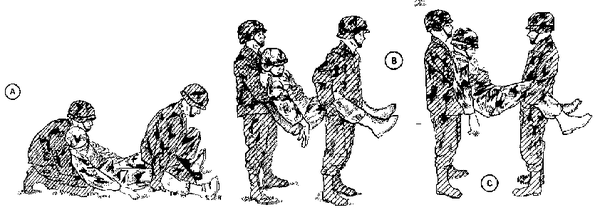Difference between revisions of "AY Honors/Basic Rescue/Answer Key"
| Line 49: | Line 49: | ||
==8. Know the proper way to help a victim, with assistance, in the following:== | ==8. Know the proper way to help a victim, with assistance, in the following:== | ||
===a. Chair carry=== | ===a. Chair carry=== | ||
| − | ===b. Fore-and -aft carry=== | + | ===b. Fore-and-aft carry=== |
| + | [[Image:Fore-aft carry.png|thumb|600px|'''A''' The shorter bearer spreads the casualty's legs, kneels between the legs with his back to the casualty, and positions his hands behind the casualty's knees. The taller bearer kneels at the casualty's head, slides his hands under the arms and across the chest, and locks his hands. '''B''' The bearers rise together, lifting the casualty. '''C''' Alternate position, facing casualty.]] | ||
| + | <br style="clear:both"> | ||
| + | |||
===c. Two-handed and four-handed seats=== | ===c. Two-handed and four-handed seats=== | ||
{| border="0" | {| border="0" | ||
Revision as of 00:54, 2 December 2006
1. What is the definition of an emergency rescue?
An emergency rescue is the act of removing someone from immediate danger.
2. Show how to safely rescue a person from the following situations:
a. Being in contact with a live electric wire
Template:First aid electric wire contact
b. A room filled with fumes or smoke
c. Clothes on fire
Template:First aid clothes on fire
d. Drowning using a non-swimming rescue
Template:First aid non-swimming rescue
e. An ice accident
3. Show three ways of attracting and communicating with rescue aircraft.
Template:First aid signaling aircraft
4. Know six indications for the need of an immediate rescue.
5. Know six procedures to follow before moving a victim from a life-threatening situation.
- The first task is to assess the whole situation and to plan the rescue.
- Know where you intend to move the victim before lifting him.
- If bystanders must be used, it is essential that they be briefed in thorough detail on what you want them to do.
- Unless the danger is immediate, any first aid should be given before moving the victim.
- Make sure that moving the victim will not cause additional injury.
- If you suspect a spinal injury, do not move the victim.
6. Know five principles involved in moving a victim from a life-threatening situation
7. Know the proper ways to help a victim, without assistance, in the following:
a. Pulling the victim
Template:First aid shoulder drag
Template:First aid blanket drag
b. Lifting the victim
Template:First aid firemans carry
Template:First aid pack strap carry
c. Assisting a victim in walking
Template:First aid support carry
8. Know the proper way to help a victim, with assistance, in the following:
a. Chair carry
b. Fore-and-aft carry

c. Two-handed and four-handed seats
The two-hand seat carry is used in carrying a casualty for a short distance and in placing him on a litter.
Only a conscious casualty can be transported with the four-hand seat carry because he must help support himself by placing his arms around the bearers' shoulders. This carry is especially useful in transporting the casualty with a head or foot injury and is used when the distance to be traveled is moderate. It is also useful for placing a casualty on a litter.
d. Blanket carry
e. Three-man hammock carry with victim in supine and prone position
f. Three- or four-man lift
g. Six-man lift and carry
9. Know how to properly use a stretcher and carry a victim on a stretcher. Know how to make an improvised litter.
Template:First aid litter carry
Template:First aid improvised litter
10. Know how to properly use ropes and knots as follows:
a. Tie knots for joining ropes together
Template:Knot square Do not let life depend on a square knot. It is unreliable. Its proper use in basic rescue is in securing the ends of a bandage.
b. Tie knots for shortening a rope
c. Tie knots for use around a person for a rescue
d. Coil and accurately throw a light and a heavy 50-foot (15.2 m) rope.
Seperate the rope into two equal sized coils, with a little less than half the rope in each coil. Choose one end that you will hang on to, and grasp it firmly in the palm of one hand, using the three smallest fingers to hold it securely. Hold the rest of that coil between the index finger and thumb, and hold the other coil in the other hand. Take aim, and throw both coils toward the victim at the same time while retaining your grip on the end. If you have difficulty with this, try standing on the end of the rope you wish to keep with you. Using this method, you can throw the rope quite a bit farther than if you had thrown a single coil. This is because the second coil will not begin to unravel until the first one uncoils. Practice until you can hit a target with the rope from the 50-foot (15 meter) mark.


